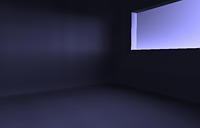

Simulating natural lighting or daylight is a particularly difficult challenge. Several problems exist with daylighting, one being the special nature of both the sun, which is essentially a very powerful directional light and the sky, which can be considered a hemispherical source covering the entire scene. Commercial software packages have significant difficulties dealing with the very fine subdivision required by the sun, and the work implied by directly treating the sky as a light source seeing the entire scene.
The problem of sharp sunlight shadows can be treated by using auxiliary image buffers to compute limits of sunlight shadows. Instead of relying directly on the mesh subdivision to capture the fine shadow boundaries produced by the sun, we generate the shadows from the sun using a hardware rendering of the scene in an appropriate auxiliary image buffer. This allows the generation of fine shadows, without the need for very fine mesh subdivision. These boundaries can also be used to guide the subdivision of the mesh.
Sky illumination is hard, and in particular when sky illumination enters from a window or another small portion of the surrounding hemisphere. The hierarchical radiosity approaches developed in ARCADE naturally concentrate work to the regions of interest by applying finer subdivision where this is needed. By taking into account the intensity of the sky at a particular time and position, this adaptive subdivision results in finer sampling and meshing in the regions required. Such conditions can be integrated into the refinement module and also can benefit from the used of well-adapted visibility computation.
We can simulate the effects of non-uniform sky distributions using hierarchical sky domes. Figure 1 show two symmetrical rooms facing west and east, respectively, illuminated by an early morning summer sky distribution (without direct sunlight). This scene presents a particularly challenging situation, in which only a small fraction of the total sky hemisphere is visible from any point in the rooms, and the sky luminance distribution is highly non-uniform. As a result, subtle illumination gradients are created on all surfaces.
Figure 1: Rooms facing west and east, illuminated by an early morning summer sky distribution
In the next example (Figure 2 and movie), we use a sky distribution with a dark blue hemisphere and a yellowish area simulating dawn conditions. Note the subtle shadowing effects on the model.
Figure 2: Complex geometry illuminated by a sky hemisphere with highly non-uniform radiance distribution. Note that no explicit sunlight is present, the colour and shadow effects are all due to sky radiance variations.
Movie: Of the illuminated dragon (avi format 2.7Mo).
We also developed an efficient algorithm for sunlight illumination. This type of illumination is usually very important, when present, since it tends to produce fairly sharp shadows with strong contrast. We use auxiliary image buffers to (a) determine visibility from the sun and (b) guide the hierarchical subdivision by automatically detecting the presence of self-shadowing effects within a cluster [Deliv. 2.4-2]. Figure 3 shows an example solution where all sky illumination components are present, together with secondary illumination effects.
Figure 3: Example image computed with sunlight and skylight, and indirect illumination. The main source of illumination in the room if the patch of sunlight on the ground.
Sky and sunlighting require specific treatment so that high-quality, usable images can be produced. The research in ARCADE has shown that hierarchical radiosity with clustering adapts very well to the treatment of skylight, in particular with appropriate visibility and refinement algorithms. For sunlight, a novel approach was required to generate the sharp shadows due to the sun, based on an auxiliary image buffer. This specific treatment for sunlight shadows is justified because of the importance and frequent use of sunlight for lighting simulation.